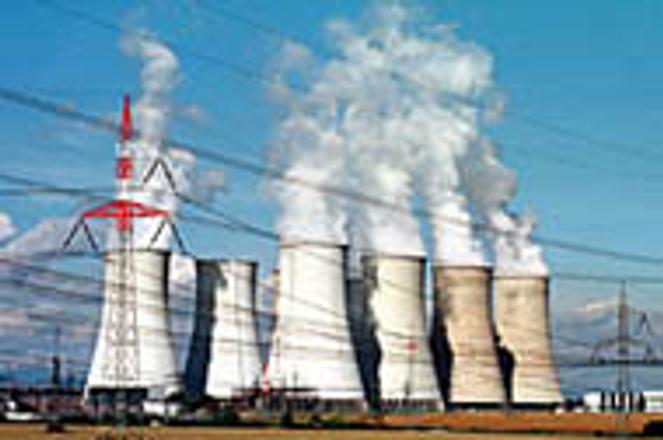Jaslovské Bohunice power plant. The planned closure of two reactors at the plant has prompted a search for replacement energy sources.photo:TASR
A massive 9.8 billion crown [$200 million] investment into a steam-gas plant in Slovakia has environmentalists smiling about the future of energy generation. Co-financed by Germany's Siemens and the Swiss company Advantage Power, the power station will not only be one of the biggest foreign direct investments into Slovakia, but could pave the way to cheaper electricity prices and an alternative to nuclear power.
Situated near the western Slovak village of Malženice, just 60 kilometres from Bratislava, the plant, expected to produce three billion kilowatt hours of energy per year - approximately 10% of the country's annual electricity consumption - will compete as an energy source with state monopoly Slovenské elektrárne (SE). Construction work on the plant is slated to begin next year, with the power facility going online by the end of 2003.
"This will be the first electricity-producing plant that does not involve Slovak investment, even though Slovaks will gain from it," said Pavol Putora, legal representative of the project's financers and developers, Malženica Power.
Government officials, analysts and environmentalists have praised the investment as a positive step away from reliance on SE and nuclear power for the country's electricity. The government's draft energy policy stresses the need to diversify energy sources by providing an alternative to electricity produced mainly by nuclear power plants.
"It is good when the country has diverse sources of electricity. The main benefit of this plant is that it will help us to do that," said Jozef Urmín, head of the regulatory department at the Ministry of Economy.
Greenpeace Slovakia's Igor Polakovie said that steam-gas plants were a future alternative to nuclear energy, explaining that in terms of carbon dioxide (CO2) pollution, the new plant would be a cleaner alternative to nuclear power. Steam-gas plants also carry a 90% efficiency rate in the use of fuel for producing electricity, while the comparative rate for nuclear power plants is 30%.
The majority of Slovakia's electricity production comes from two nuclear power plants, Bohunice and Mochovce, both owned and run by SE. Bratislava has been under increasing pressure from the European Union, especially from neighbouring Austria, to scale down its nuclear programme.
The Slovak government decided in September last year to fall in line with EU regulations on nuclear energy production and decomission the first and second reactors at the Jaslovské Bohunice power plant between 2006 and 2008. The move prompted a search for replacement energy sources; the V1 and V2 reactors were originally scheduled to be replaced by two reactors at the nuclear power plant in Mochovce, but the government refused to support this plan earlier this year, saying it would not provide any direct or indirect guarantees for Mochovce's completion.
Despite this, some coalition members still appear reluctant to back full-scale moves away from nuclear energy sources. Sector analysts have criticised the government for its slow pace in dealing with ageing nuclear power plants, claiming that the coalition has bowed to pressure from a pro-nuclear lobby operating within the government, most notably the Democratic Left Party (SD1), closely associated with SE.
The Economy Ministry's Urmin confirmed that the government still remained committed to nuclear energy as Slovakia's main power source for the foreseeable future. "We view nuclear energy as a renewable source, meanwhile gas and coal are not renewable. We are slowly but surely running out of these energy sources. Taking this into consideration, we believe that nuclear power is the energy of the future," Urmín said.
Cheaper prices
According to Putora, the Malženice plant could fill the supply hole that will be left once Bohunice's two reactors are decomissioned. "Fifteen percent of existing energy producers in Slovakia will have to be replaced in 10 years time, and our plant might well replace them. In a global context, this is one of the reasons why construction of the plant is important."
The plant's contruction will also have an effect on electricity prices, which have risen twice since the government came to power in autumn 1998. Putora added that electricity produced by steam-gas plants may be cheaper because the investment could be recouped in a much shorter time than a similar investment into a nuclear power plant.
"Construction of the Malženice plant will be six times less expensive than construction of any nuclear power plant, which would be positively reflected in the price of [energy from the] plant for customers. This is something which will allow us to offer widely acceptable prices once the market is liberalised [energy prices are to be freed from government control in 2003 - ed. note]," Putora said.
He added that the plant had an extra investment cost advantage of being constructed on a site which had previously housed a station for compressing gas, with all infrastructure therefore already in place. In not having to pay for construction of the infrastructure, Malženice would have a further advantage when the energy sector was fully liberalised. "In 2003 we have to be ready for de-regulation of the market and make sure that our prices will be competitive from the very beginning," Putora said.


